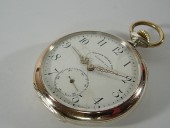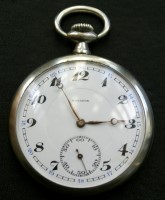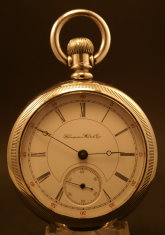
![]()
|
|
Mottu Brothers of Geneva1860s |
||
|
|
Mottu Brothers of Geneva were well-known watch and clock makers of Geneva, active from 1842 to 1875. According to a source Mottu family manufactured clocks and watches and their cases for E. J. Dent of London between 1842-1862. The family mentioned in Geneva in 1857 and 1860. The same source mentiones David Mottu as the founder of the Mottu company. Brian Loomes mentiones the Mottu as Mottu Brothers and Son of London, probably due to the trade relation to E. J. Dent of London, and gives the dates between 1839-1875.The pocket watch by Mottu of Geneva shown here is in the lépine or open face style, made of 0, 800 k silver. Hinges are of lower carat gold. According to the other source the maker is Adolphe Mottu and it is evident that this maker is a relative of other Mottus. Please find the refence here.The dial is typical white enamel, Roman numerals for hours , sunken seconds dial with gold indicator. It has Brebetween guet or Moon style hands. Mottu Geneve signature placed 8 and 5. The back has been monogrammed as M G (Mottu Geneve) in the middle of worn engine turning decoration. This Mottu watch has typical middle of the 19th century polished steel cylinder escapement, barrel bridge movement with spiral steel hair spring movement, engraved with Mottu Geneve. I can estimate the date of manufacture as 1870s.References: Brian Loomes, Watch Makers and Clock Makers of the World II, N.A.G.Press, London, 1976: 165. Mottu'lar ya da Mottu kardeşler bir kaç kaynakta adına rastlanan Cenevre merkezli cep saati, masa ve duvar saati yapımcısı bir ailedir. Bir kaynakta bu ailenin fertlerinden birinin adı David olarak geçmektedir. Mottu Kardeşler 1840 yılından itibaren saat üretimi yapmışlar, özellikle 1842-1862 yılları arasında Londra'da E. J. Dent adlı saat yapımcısı ve satıcısı için İngiliz pazarına saatler üretmişlerdir. Aynı zamanda 1857 ve 1860 yıllarında Cenevre adını kullanma ruhsatı almışlardır. Loomes da Mottu ailesini kardeşler ve oğul Mottu olarak zikretmektedir ve faaliyet tarihlerini 1839-1875 ve Londra kenti olarak vermektedir. Bu sayfada yer alan cep saati, gümüş kasalı, kasa tipi "lépine/open face/yüzü açık" denen kadranı sadece çerçevesi gümüş bir cam tarafından korunan, arka kapağı bir dil yardımıyla açılan, yine aynı biçimde açılan toz kapağına sahip bir kasadır. Kasanın menteşeleri düşük ayar altındandır, arka kapak balıksırtı motifle bezenmiştir, ancak bezeme kullanımdan dolayı aşınmıştır, ortada M G (Mottu Geneve) inisiyalleri bulunur. Kadran beyaz mineden imal edilmiş, romen rakamlı saat başları, 10 dakika aralı saniye çukuru olan bir kadrandır. Kadranda 8 ile 5 arasında yapımcının adı ve imalat yaptığı kent Mottu Geneve olarak yazılmıştır. Akrep-yelkovan Breguet ya da Ay stilindedir. Mekanizma tipik 19.yüzyılın ikinci yarısı silindir eşapmanlı, çarkların köprü biçimli ince dikdörtgen baskılara oturduğu, spiral çelik pandüllü, İsviçre mekanizmasıdır, altın kaplama pirinçten imal edilmiştir. Mekanizma üzerinde de yapımcının adı Mottu Geneve olarak kazınmıştır. Kaynaklar: Brian Loomes, Watch Makers and Clock Makers of the World II, N.A.G.Press, London, 1976: 165http://www.worldtempus.com/pit/wtpop/2/11629/5087 son izlenme tarihi 07-03-2007
|
||
|
Kleinert & Co Pocket Watch Late 19th Century to Early 20th Century |
||
 |
This pocket watch sold by Kleinert & Company branded as Bremer Börsen Uhr. It is appearent that this pocket watch was presented by Walter and Dieter Rogge to one of their leading customer as those names were carved on the inner back case . BTW we can consider these people were stock exchange brokers in the Bremen Stock Exchange since the watch was sold by the company trading around the stock exchange vicinity in Bremen. The case has two gilt rims both on the bezel and the back case which has the traces of time. The case is made of 0.800 silver and bears Swiss export and German import hallmarks with K&M maker's marks and serial numbers. K&M according to Kochman, is the company of Kramer and Moser and located in Biel, Switzerland and registered in 1882. The white enamel has some cracks and repair at 5 o'clock which shows it was once dropped and one of the dial feet was released from its place and gave the dial a couple of cracks. The dial has arabic hour markers and big sunken subseconds dial at six o'clock. The hands are of elaborate Rococo style and gilt as well as sub seconds hand.The pocket watch is a stem wound one. The movement is a high grade 16 jewel anchor escapement movement with a screwed balace wheel and Breguet hair spring. Four of the jewels are placed in (gold?)chatons. The missing micrometric regulator has recently been placed with a new one and time keeping quality increased. The movement by its appearance, was produced by Seeland Watch Company IMHO.
|
|
|
Swiss Made Pocket Watch with Anchor Escapement 1880s |
|||
|
|
This pocket watch is similar to 12 size American pocket watches. It has a silver open face case, but there is no silver hallmarks. FR initals are placed into the inside of the back case, this is perhaps the watch maker's initials and the maker of the watch may be F. Rotig of Havre. The dial is snow white enamel with roman hour markers, arabic minute chapters and sunken sub seconds dial. Second hand and hands are made from blued steel. The back case is adorned with Art Nouveau-ish floral motifs. Dust cap is of brass and numbered 9202 as well as back case. The movement is in bridge plate style and gilt with 15 jewels. Anchor escapement and has very interesting open ended pallet fork, escapement and balance wheel is made of steel. The dust cap is inscribed "Remontoir" which shows the watch is stem wound. And as an early feature it is pin set. Due to the fact that there is no silver hallmarks on the silver case the date of manufacture should be early 1880s. |
||
|
|
Swiss Made Silver Pocket Watch with Anchor Escapement 1880s |
|
|
|
This pocket watch is 4.9cm in diameter. It is housed in an open face silver case which has gilt circular borders both on bezel rim and back case. The dial is white enamel with roman hour markers and arabic numerals on minute chapter and sunken sub seconds dial. It is a stem wound and pin set pocket watch. The silver case has no silver hallmarks but E.V maker's initials and 44622 serial numbers. The dust cap has the inscription reads: "Ancre Ligne Droite, 15 Rubis, Spiral Breguet, Remontoir" which means stem wound, Breguet hair spring and anchor escapement. Those features can be found true when one looks at the movement. The movement is of bridge plate style, 15 jewels, and gilt. The screwed balance wheel has a Breguet hair spring and connected to anchor escapement, the pallet fork is in circular shape which resembles the Le Coultre calibre. This pocket watch, with the absence of silver hallmarks, can be dated to 1880s or slightly before. The back case has worn engine turning motif and floral cartouche in the middle and dust cap is adorned with meander motif circulating around the inscription. |
|
Perret & Fils, Brenets, Pocket Watch 1890s |
|
|
|
Perret & Fils founded in 1854, by the father of the more famous son by the same name.David Perret (the son) was appointed as one of the Swiss members of the jury for the horology section of the Paris exhibition in 1878.David Perret et fils registered its trade mark (the fleur de lys) in 1880 for watch movements and case backs. The firm won a honorable mention at the National Exibition of Holrology in La Chaux de Fonds in 1881.In 1883 the firm employed 300 workmen and produced 50,000 pieces a year, all of good quality.David Perret patented about 10 inventions, including an electric clock.Perret was granted a US patent No 378974 on March 6 1888 for a stemwound watch. This patent was used by the American Watch Company of Waltham in its stem-wind hunting "Special".The firm exibited at the Paris Exhibition in 1889. For the reference click HERE. This pocket watch has a steel (gun metal) case and stamped in the back case with "Acier RG Garanti" indicating the whole body of the case is made of steel. The white enamel dial has roman chapter ring and arabic subsidiary seconds dial. Hands are gilt and elaborate, and second hand is blued steel. It is a stem wound and pin set pocket watch. The movement is a bridge plate type and chrome plated with anchor escapement and jewelled pallet fork. The movement is adorned with Geneva stripes and has 15 jewels. Due to the course of time and bade treatment of the previous user(s) the case has several scratches and weird inscriptions as well as the ones on the bridges of the movement. However this does not affects the glory of the appearance of the pocket watch since it is made of steel. This pocket watch has been serviced and cleaned by watch maker Mr. Karakaya of Berlin, on April, 8th,2009.The watch carries a couple of writings on its dust cover and inside the caseback as well as on the bridges of the backplate. The only legible writing is the name of a woman who possibly lived in the Tsarist Russia and her name is as follows: Елианора никифоровна шаповалова |
|
Simplex Antimagnetique Pocket Watch 1890-1900s |
||
|
|
This pocket watch is the biggest one that I have, it is 6.8cm in diameter. It is housed in a gun metal case. The enamel dial has roman chapter ring and sunken subseconds dial has an arabic chapter. Blued steel spade hands. The dial has been marked with a roundel on which Simplex and Antimagnetique inscribed and in the middle a watch maker's lathe is illustrated and E.W & F initials are placed underneath. The movement is of Le Locle type and high quality damascened and nickelled movement of 15 jewels count. It has a Swiss anchor escapement with compensated balance wheel and steel breguet hair spring . I presume it is an 8 day pocket watch. The movement has an emblem with a flying bird holding a leaf initialled with J.B on its beak. This emblem once belonged to Les Fils de Jeanneret-Brehm of St.Imier. There is a strange coincidence if the dial and movement belongs to different companies, because both of them located at the same town . Or possibly Droz & Cie merged with Les Fils de Jeanneret-Brehm. The firm Les Fils de Jeanneret-Brehm was founded by Jules-Frédéric Jeanneret in Saint Imier in 1866 and employed the name "Les Fils de Jeanneret-Brehm" and used a brand name "Colombe" from 1891 onwards and the firm has been closed in 1984. Please click HERE for the reference. |
|
|
Chronometre Herma Pocket Watch by Mathey Freres & Cie. ca.1920
|
|
|
|
This pocket watch is labelled on the dial as Chronometre Herma. It is stamped both on the front plate and back plate with the emblem of Mathey Freres & Cie. of Tramelan /Dessus (Lion rampant holding a capital "L"). Mathey Freres were the manufacturers of high quality time pieces and were active from the late 19th century to first half of the 20th century. It is known that the firm registered trade mark of Prima for watch cases, movements, dials in 1892, and they registered the trademark of lion rampant in 1895. Dial: White enamel dial is a 24 hour style dial. It has a bigger 12 hour arabic chapter ring and a smaller 24 hour arabic chapter which takes place on outer ring. The dial is in the style of double sunken dial and has blued steel spade hands and sunken subseconds with a blued steel minute indicator. Case: Steel. Movement: High end 19 jewels, gilt bar movement with a bi-metallic screwed balance wheel, micrometric regulator, breguet hair spring , lever escapement which is found in the pocket watches made by Agassiz, C.H. Meylan, Patek Philippe. The trademark of the firm is stamped near the balance cock and on the front plate with the number 89(calibre numbers). This pocket watch evidently illustrates that the firm had issued brand Herma in the early 20th century as well as Prima. |
 |
Matador Pocket Watch by Phenix Watch Co. SA ca.1920
|
|
|
Phenix Company History The 'Phenix Watch Co., SA' was founded in Porrentruy in 1873 as 'Dubail, Monnin, Frossard & Cie.' Pritchard points out that the company set a mark in Swiss watch history as it was the first watch company that had a registered caliber.On February 3, 1900, the company 'Dubail, Monnin, Frossard & Cie' was registered as 'Société d'horlogerie de Porrentruy.' They won a gold medal at the Paris Exposition in 1900 already under the new name.Simultaneously, the formerly independent 'Société d'horlogerie de Bassecourt' was integrated into the new company. The Société Horlogère de Porrentruy 'inherited' from Bassecourt the trademark 'Rooster with Chickens' that had been registered in 1883.The 'Société Horlogère de Porrentruy' changed its name to 'Phenix Watch Co.' in the 1920s.For reference please click here. Matador is one of a couple of brands used by Phenix Watch Company. Dial: White enamel dial is a 24 hour style dial. It has a bigger 12 hour arabic chapter ring and a smaller 24 hour arabic chapter which takes place on outer ring. The dial is in the style of double sunken dial and has gold color breguet/moon style hands and sunken subseconds with a blued steel minute indicator. Case: Stainless alloy. Movement: High end 17 jewels, gilt bar movement with a screwed bi-metallic balance wheel, , breguet hair spring and anchor escapement . The name of the brand is stamped on the centre bridge and the calibre number is engraved under the balance wheel as 872. The movement has four jewels with chatons.
|
 |
Hampden Open Face Pocket Watch 1897
|
|
|
Hampden Watch Company History The history of the Hampden Watch Co. goes back to the New York Watch Co., a successor to the Mozart Watch Co. The New York Watch Co. ... was in business from about 1866 to 1877, during which time it made a variety of different grades of movements. Its total production is estimated to be less than 60,000. After a reorganization, the firm became the Hampden Watch Co. in 1877.John C. Dueber had been manufacturing watch cases since 1864 and bought controlling interest in a case company in about 1886. At about this time an anti-trust law was passed and the watch case manufacturers formed a boycott against Dueber. In order to remain in business, Dueber bought the Hampden Watch Co. in Springfield in 1888, then moved it to Canton. By 1890, the company was producing 600 watches a day, had 1000 employees, and possessed net assets of $2,600,000. Hampden produced some very fine quality watches, and introduced the first 16 size, 23 jewel movement made in America.Dueber controlled all aspects of the company from manufacturing to sales. Each watch case was made of 57 pieces; they used 14-karat-gold cases and 17 jewel movements. Dueber sold the company to Walter Vrettman in 1925. Vrettman went bankrupt in 1927 and sold all of the company's equipment to Amtorg, a Russian purchasing company. Nearly 30 boxcars of machinery left Canton in 1931 with 21 former Dueber Hampden employees who contracted for one year to teach the Russians the craft of watchmaking. Conflicting information exists about the fate of the Russian enterprise, but Henry Fried, a horology professor at New York University, reported seeing Dueber-Hampden machinery being used in China in 1986. Joseph Fahy & Company History The
book History
of
the American Watch
Case,,
has the following to say about Joseph Fahys & Co. (which
includes
additional Notes
in Brown by Michael Harrold):
Joseph
Fahys came to the United States in 1848 and opened a shop
in New
York City in 1857. In 1861 he built another factory in
Carlstadt, NJ
and ran it under the name of Foutenbach & Sons (Or,
the Fortenback case company in Carlstadt was
organized and built entirely by the Fortenbach family,
although Fahys
may have been their distributor)
until 1878 when it was re-named under Joseph Fahys.
In 1882, operations moved to Sag
Harbor,
NY,
which is a former whaling port on Long Island (and
where Fahys' wife was from).
Dial: White enamel dial with Roman hour chapters, on the outer rim minute counter and red minute chapters.The dial has a sunken sub seconds dial with blued steel seconds hand. Hour and minute hands are in Breguet style and blued steel. The dial marked with "Hampden Watch Co." Case: Fahy's Ore Silver in other words nickel alloy. Caseback is decorated with the image of the Brooklyn Bridge. Movement: High end , Rail Road grade 17 jewels, nickel full plate movement with a screwed bi-metallic balance wheel, , breguet hair spring and anchor escapement . The movement is incribed with Hamdpden Watch Co., Canton, Ohio, Safety Pinion, 17 Jewels, Adjusted and the serials: 1100003. The movement has five visible jewels with gold chatons. Size: 18 Grade: 81 Model: 3
|